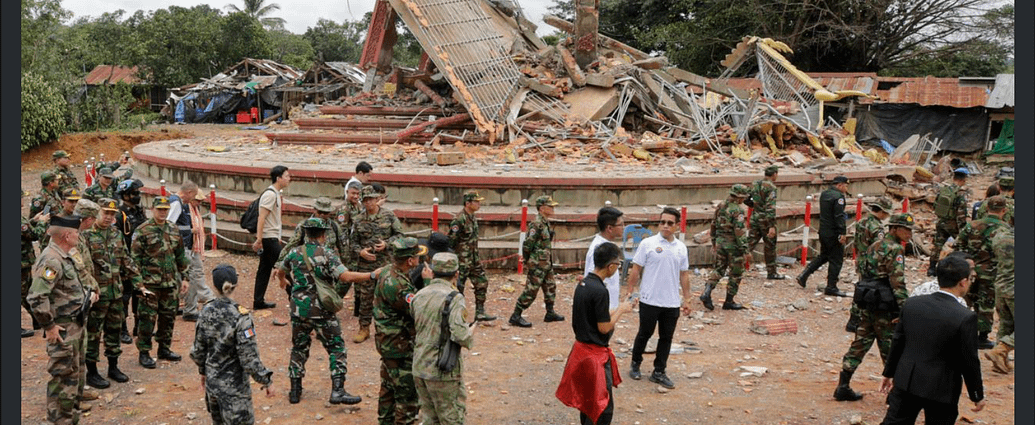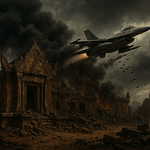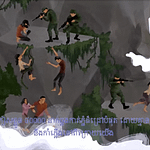PHNOM PENH – The Cambodia-Thailand border conflict, ignited by a May 28 incident in which a Khmer soldier was killed by a Thai soldier close to the Ta Moan Thom temple, rekindled the Cambodia-Thailand border dispute, which has since grown into a serious humanitarian and legal problem.
Cambodia accuses Thailand of violating international law by using prohibited cluster munitions to start hostilities, attacking holy sites, and putting civilians in danger.
Thailand’s use of fighter jets and heavy artillery has increased tensions even more, causing thousands of people to be displaced and escalating cross-border violence. Thailand’s disproportionate and forceful response to Cambodia’s growing death toll and devastation raises the possibility of full-scale conflict and calls for immediate international accountability.
Roots of the Conflict
The 817km border, which was formed by colonial treaties such as the Franco-Siamese Agreement of 1904, has long been a source of contention over Khmer monuments like Ta Moan Thom and Preah Vihear.
A sequence of significant events demonstrates this tension: a border treaty was negotiated between France and Thailand in 1907; Thailand captured the Preah Vihear temple in 1954; the International Court of Justice (ICJ) declared it to be part of Cambodia in 1962; and in 2008–2011, crossfire near the temple killed scores of people.
The current situation was sparked by the killing of a Cambodian soldier by Thai forces on May 28 and a phone conversation between former Prime Minister Hun Sen and Thai Prime Minister Paetongtarn Shinawatra that was leaked in June 2025 and resulted in her suspension.
Since then, clashes have left up to 200,000 people displaced as of July 28, 2025, injured over 130 people, and killed at least 32 Cambodians and Thais, the majority of whom were civilians.
The July 28 ceasefire brought a temporary halt, though mistrust lingers. Cambodia claims that Thailand’s actions violate international humanitarian law and jeopardize the stability of ASEAN.
Article 2(4) of the UN Charter, which forbids using force against territorial integrity, emphasizes Thailand’s duty to look for peaceful solutions.
Cluster Munitions: A Prohibited Weapon
Due to the indiscriminate and chronic harm that cluster munitions cause to civilians, the Convention on Cluster Munitions (CCM), which was ratified in 2008 and went into effect in 2010, forbids their use, manufacture, transfer, and stockpiling.
These weapons, which spread explosive submunitions across large areas, frequently leave unexploded ordnance that puts lives in danger long after hostilities end, especially those of children and farmers.
Both countries are encouraged to abide by international law and Cambodia claims that Thailand violated the CCM by using cluster munitions in Oddar Meanchey in 2011 and again in July 2025.
There has been “indiscriminate harm” to villages, according to reports, and there are serious concerns about unexploded ordnance that remains.
Thailand’s purported assertion of “military necessity” runs counter to both the absolute ban of the CCM and the proportionality principle of the Geneva Conventions, which requires minimizing injury to civilians.
Desecration of Cultural Heritage
By using F-16 fighter jets to carry out airstrikes close to the UNESCO World Heritage-listed Preah Vihear Temple, Cambodia has accused Thailand of violating the 1954 Hague Convention for the Protection of Cultural Property in the Event of Armed Conflict.
Since July 24, the attacks have seriously damaged the temple and its surroundings, including access roads and historic buildings. Because of the temple’s great significance as a symbol of Khmer heritage, Cambodia’s Ministry of Culture denounced the strikes as a “cultural disaster and moral tragedy,” claiming they amount to “cultural genocide.”
The 8th and 9th Support Infantry Division Headquarters are among the Cambodian military locations that Thailand’s military claims were targeted by the strikes, although it has not produced any proof to support this allegation, leading to charges of willful violation of international law.
Cambodia and Thailand are deeply outraged by these measures, which have heightened nationalist tensions. Cambodia is appealing to the UN Security Council for intervention.
Civilian Toll and Displacement
Since July, the conflict has wreaked havoc on civilians. Along with Cambodian shelling in Surin, Thai airstrikes and artillery in Preah Vihear and Oddar Meanchey have killed non-combatants, including an eight-year-old boy, and injured scores more.
Thirty-five thousand Cambodians and more than 130,000 Thai people have fled, and shelling has devastated schools and hospitals, including one in Surin. The 1949 Geneva Conventions, namely Common Article 3 and Article 8 of the Fourth Convention, forbid attacks on civilian targets such as residences, hospitals, and schools and require that combatants and civilians be distinguished.
International observers and Cambodian officials have condemned Thailand’s use of superior weaponry for escalating this humanitarian situation.
Use of Aircraft to Deploy Toxic Smoke
Since July 2025, Thailand has been accused by Cambodia of using planes to drop hazardous chemical agents over civilian border communities in Oddar Meanchey, resulting in extensive respiratory distress, environmental destruction, and suffering for civilians.
The 1997 Chemical Weapons Convention (CWC), an international agreement that has been ratified by 193 governments and that forbids the use, development, manufacture, stockpiling, and transfer of chemical weapons, is being seriously violated by this suspected use of chemical weapons (Chemical Weapons Convention, 1997).
In particular, Cambodia alleges that Thailand has violated Article I of the CWC by targeting vulnerable groups. The article expressly forbids the use of harmful substances to injure or kill people via contact or inhalation.
Thailand strongly denies these allegations, labeling them “fake news,” while eyewitness accounts from Oddar Meanchey describe a yellowish haze enveloping villages, leaving residents struggling to breathe and raising fears of war crimes that challenge the foundations of international humanitarian law, including the 1949 Geneva Conventions’ protections for civilians.
Ceasefire and Path to Lasting Peace
The ceasefire deal, which ASEAN mediated, is a vital step in defusing the violence along the Cambodia-Thailand border, but it depends on both countries’ strong cooperation and openness.
An ASEAN-appointed mission headed by Malaysia has been entrusted with supervising the ceasefire’s execution, keeping an eye on adherence and promoting communication to resolve underlying conflicts.
Thailand and Cambodia must agree on a number of important measures to guarantee enduring peace. To start, both countries should quickly remove their heavy weapons and troops from the border areas, especially those close to disputed locations like the temples of Ta Moan Thom and Preah Vihear, to lower the likelihood of further fighting.
Secondly, the Malaysian team and stakeholders such as specialized organizations must be allowed unfettered access to the battle areas in Preah Vihear, Oddar Meanchey and Surin to confirm adherence to the ceasefire, look into claims of the use of cluster munitions and chemical weapons, and evaluate the damage to sites of cultural property.
Third, both nations should have regular open talks through the Joint Boundary Committee (JBC) with the goal of elucidating boundary demarcations based on past treaties and decisions from the International Court of Justice (ICJ), including the 1962 Preah Vihear case.
Trust might be further increased with the help of ASEAN and possibly UN observers through cooperative patrols and impartial monitoring systems.
Prioritizing humanitarian assistance is also necessary for Cambodia and Thailand to guarantee the safe return of displaced civilians and to offer medical and psychological support to those affected.
If the Malaysian delegation does not properly cooperate, ASEAN’s reputation might be damaged and the situation could worsen, requiring more forceful action from the International Court of Justice or the UN Security Council.
Both countries may turn the shaky truce into a basis for long-term peace and regional stability by following these guidelines.
Demand for Accountability
There is an urgent need for an independent investigation of the increasing use of illegal techniques, such as cluster munitions, targeted attacks on UNESCO World Heritage sites like the Preah Vihear Temple, civilian casualties and the use of hazardous chemical agents over populated areas.
Although the ceasefire that ASEAN established on July 28 was a step in the right direction, it hasn’t been sufficient to ensure enduring peace.
To protect civilians, unearth the truth and preserve priceless cultural legacy, the UN and the Organization for the Prohibition of Chemical Weapons (OPCW) have demanded that the world step in right away. To bring peace and stability back to the region, persistent diplomatic efforts are more important than ever as displacement and human suffering increase.
This article was originally published in Cambodianess. It is republished here with proper attribution. You can read the original version: https://cambodianess.com/article/thai-aggression-violates-international-law







